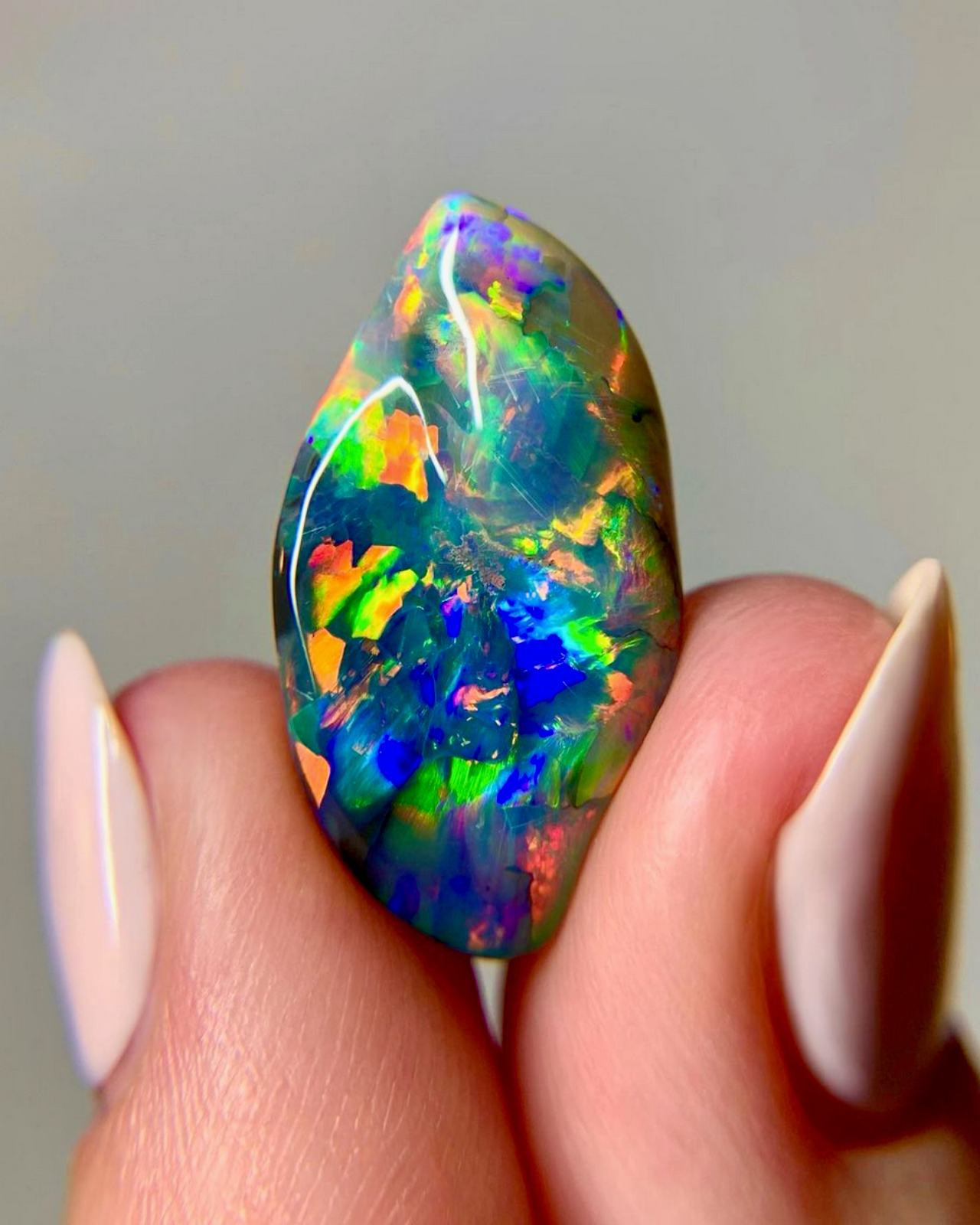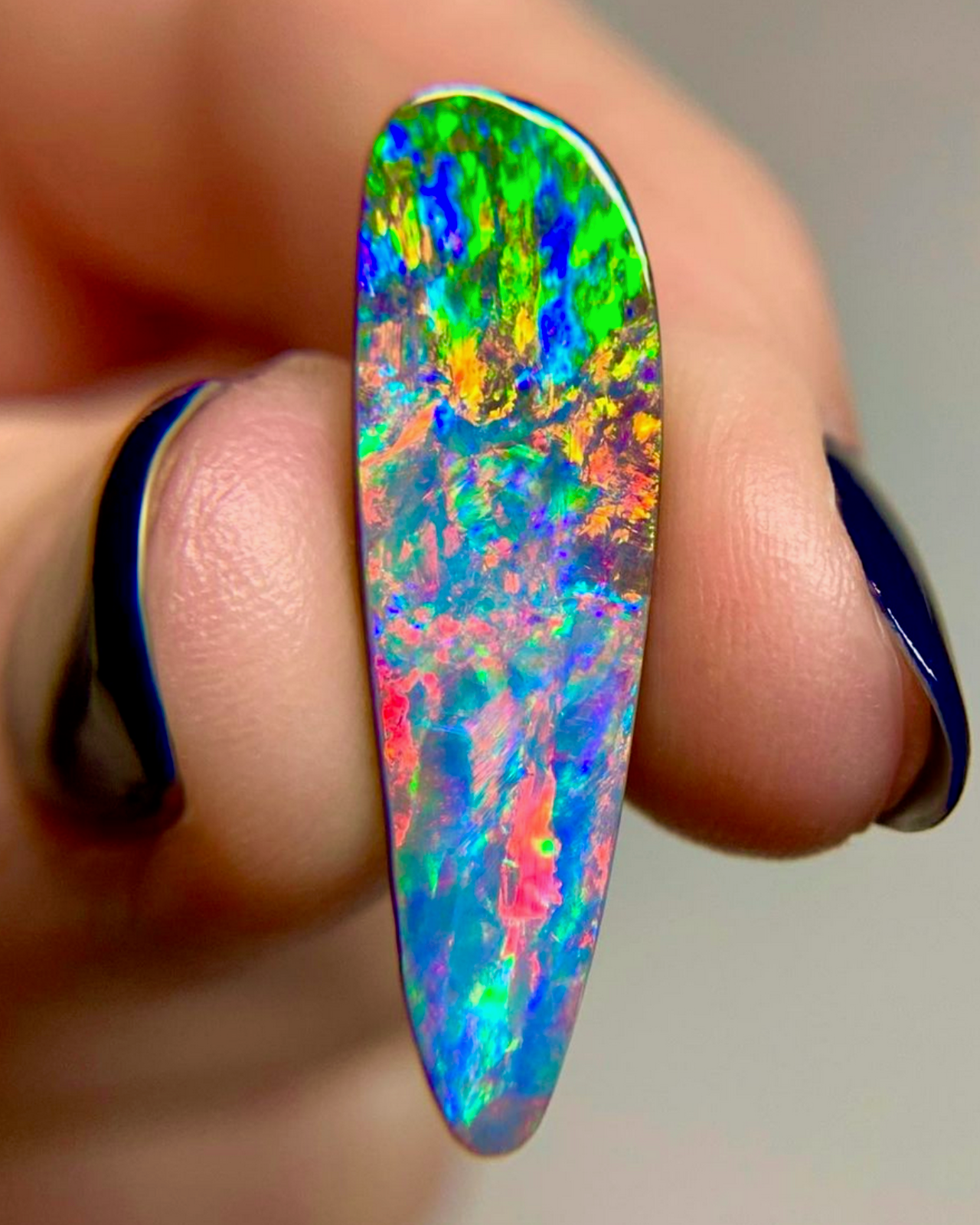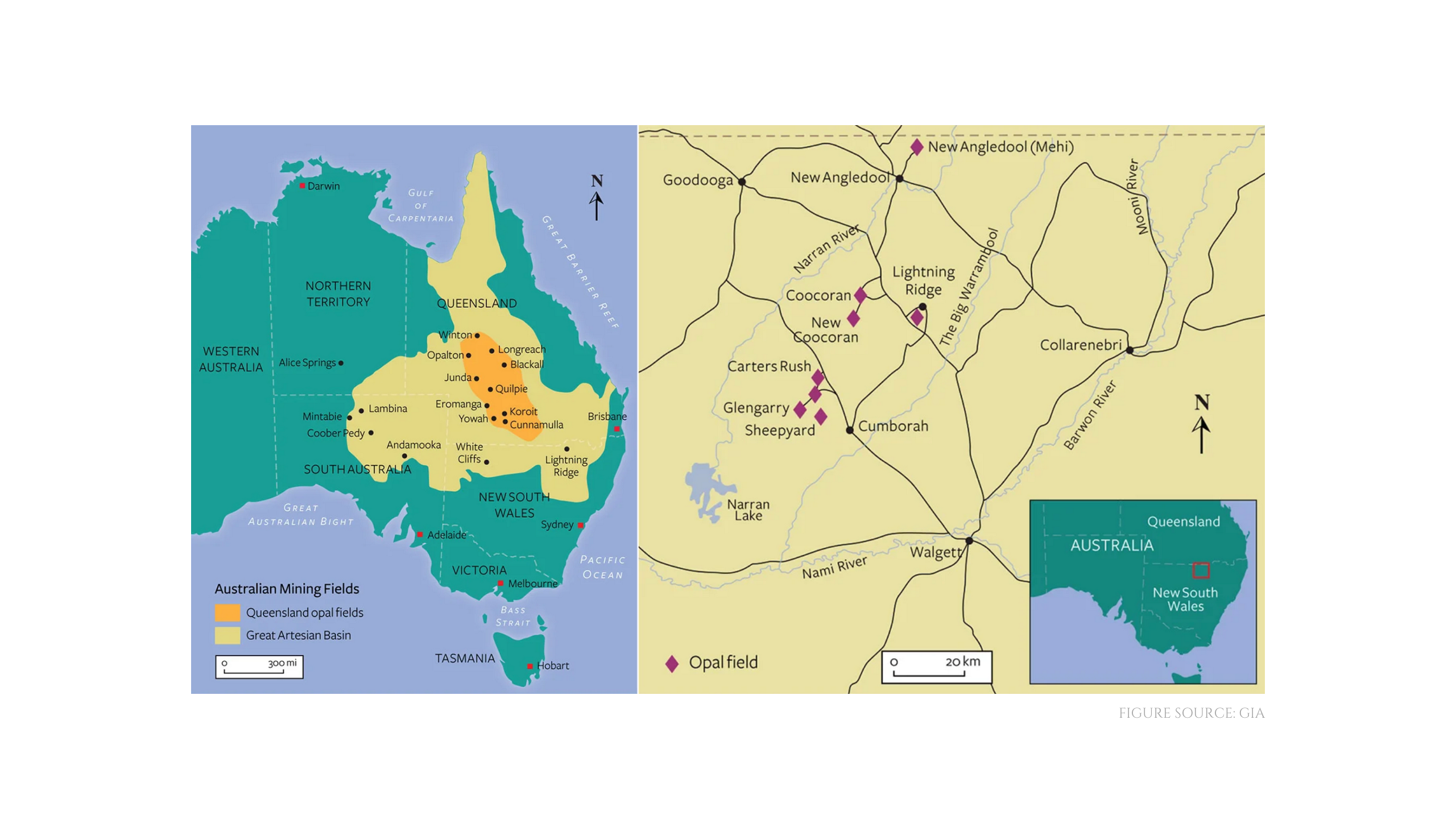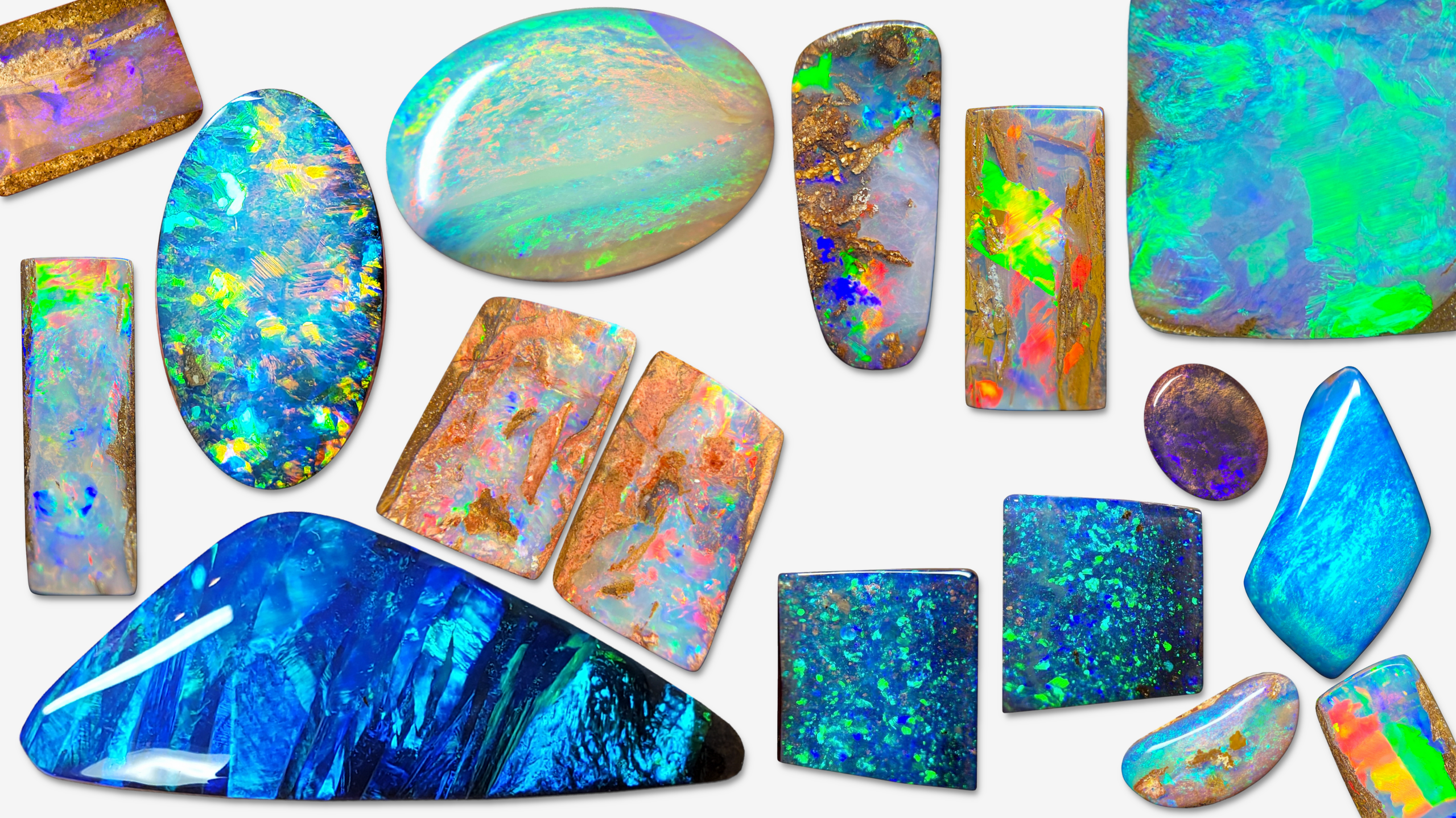
Opal EDU
Opal is a hydrated amorphous form of silica (sio2·nh2o). When opal is formed, silica gel fills crevices in rock. As water evaporates, the silica is deposited in the form of tiny spheres. It is deposited at a relatively low temperature and may occur in the fissures of almost any kind of rock, being most commonly found with limonite, sandstone, rhyolite, marl, and basalt.
- Mineral: hydrated silica
- Refractive index: 1.37-1.47
- Specific gravity: 2.15 (+0.08, -0.90)
- Mohs hardness: 5.5 to 6.5
- Birthstone: October
- Anniversary gift: fourteenth
- National gemstone: Australia
There are two broad classes of opal: precious and common. Precious opal displays play-of-color, common opal does not. The internal structure of precious opal makes it diffract light, as the lightwaves travel between the spheres, the waves bend. Play-of-color occurs because opal is made up of sub-microscopic spheres stacked in a grid pattern. As they bend, they break up into the colors of the rainbow, creating the play-of-color. Depending on the conditions in which it formed, opal occurs in different colors. They vary in optical density-ranging from semi-transparent to opaque. Precious opal can be clear through white, gray, red, orange, yellow, green, blue, magenta, rose, pink, slate, olive, brown, and black. Of these hues, black opal is the most rare, whereas white opal is the most common.
Opal can be found around the world, with Australian opal regarded as the most precious and valuable.
- Australia: solid (black, dark, light, crystal), boulder, and matrix
- Ethiopia: solid (volcanic, hydrophanic)
- Mexico: solid (fire opal / water opal) and boulder (fire opal matrix)
- Brazil: solid (sedimentary light opal)
- Peru: solid (blue and pink common opal)
Other sources include Canada, Czech Republic, Guatemala, Hungary, Honduras, Indonesia, the United States and in 2008, NASA announced it had discovered opal deposits on Mars.

Main Types of Opal
- Crystal / Water Opal: transparent to semi-transparent, with a clear background and often vivid with strong play-of-color
- White / Light Opal: translucent to semi-translucent, with play-of-color against a light body-color
- Black / Dark Opal: translucent to opaque, with play-of-color against a black or grey body tone
- Fire Opal / Mexican Opal: transparent to translucent, with red, orange, yellow, or brown body-color
- Boulder Opal: translucent to opaque, with play-of-color against a light to dark background and rock matrix
AUSTRALIAN OPAL
Opal is the product of seasonal rains that drenched dry ground in regions such as Australia’s semi-desert “outback.” The showers soaked deep into ancient underground rock, carrying dissolved silica (a compound of silicon and oxygen) downward.
Production of precious opal began at White Cliffs, New South Wales in 1890, from Opalton, Queensland in 1896, and at Lightning Ridge, New South Wales in 1905.
Current major opal mining locations in Australia are the South Australian opal fields (Coober Pedy, Andamooka, and Mintabie), Lightning Ridge area, and Queensland.
Lightning Ridge produces the most valuable type of opal on the market. The high quality, rarity, and uniqueness makes black opal highly sought after for fine jewelry designers and investment collectors. This, however, creates challenges due to the fact that there are more buyers than mines, making gem-quality opal scarce.
Opal Mining Fields of Australia

Opal Classification
Classification is based on transparency and body color. Transparency ranges from transparent (crystal opal), translucent (semi-crystal opal), to opaque. Body color includes black opal, dark opal, and light opal.
The base body tone refers to the darkness of the opal ignoring the play-of-color and brightness of the stone. The body tone can only be determined by looking down on top of the stone, ignoring the material on the back of the stone. Only those stones ranking N1 to N4 are considered black opals - attracting additional value associated to this class.

Black Opal
The Lightning Ridge region of New South Wales stands renowned as a producer of one of the world's most exquisite and exclusive natural gemstones: the Australian black opal. What distinguishes black opal is its captivating play-of-color, a phenomenon that unfolds against a body color ranging from dark gray to jet black. This unique contrast elevates black opal to a league of its own among opal varieties. The play-of-color is a mesmerizing interplay of vibrant flashes and intricate patterns of spectral hues which seems to come alive as the stone is viewed from different angles and lighting conditions. Among connoisseurs and collectors, the most sought-after specimens boast a deep, lustrous black body tone adorned with vivid bursts of patterns of full-spectrum color, including captivating hues of red and orange.

Crystal Opal
Australian crystal opals are found in various regions across the country, with notable locales including Lightning Ridge in New South Wales and Coober Pedy in South Australia, both renowned for their crystal opal deposits. Australian crystal opal is known for its transparency and dynamic play-of-color, which seems to dance and shimmer within the gemstone. The term crystal opal generally applies to any class of opal such as light, dark, or black opal which has a translucent, lucid, or semi-translucent body. In contrast to common opals, which often exhibit a milky or opaque appearance, crystal opals are characterized by a transparent to translucent body, permitting light to permeate through and accentuate the brilliance of their colors. The most esteemed Australian crystal opals are those that exhibit a combination of high transparency, vibrant play-of-color, intense brightness, and impeccable clarity.

Boulder Opal
Australian boulder opals are a unique variety of opal found exclusively in Queensland, Australia. The major mining areas for these exceptional gemstones include Winton, Yowah, Koroit, and Quilpie. These opals are formed through a unique geological process, where thin veins of precious opal fill underground fissures within ironstone boulders. The formation of boulder opals results in distinct flat or undulating surfaces, rather than the traditional domed cabochon shape. Consequently, these opals are typically cut into free-form shapes, maximizing the size and natural beauty of the stone. One of the defining characteristics of boulder opals is the layer of solid brown ironstone left on the back of the stone, creating an inherent dark backing that enhances the vibrancy and play-of-color in the opal. "Clean faced" boulder opal specimens, where the entire color-bar is visible without any ironstone on the surface are the most highly sought-after and valuable variety.

Doublet Opal
A doublet opal is an assembled gemstone that combines two distinct layers of natural materials through a precise adhesion process. The top layer comprises a thin slice of natural opal, typically vibrant crystal opal or other light opal varieties. The bottom layer, on the other hand, consists of a dark backing material, often ironstone or black potch (common opal), selected to enhance the visual appeal of the opal slice. The creation of doublet opals serves two primary purposes: 1. Utilization of Fragile Opal Slices: By adhering a thin slice of opal to a sturdy backing, doublet opals provide a means to utilize opal pieces that would otherwise be too delicate and prone to breakage for jewelry settings, thereby minimizing waste and maximizing the use of this precious gemstone. 2. Color Enhancement and Cost-Effectiveness: The dark backing material employed in making doublet opals serves to accentuate the play-of-color exhibited by the thin opal slice, mimicking the appearance of a solid precious black opal. This technique offers a more affordable alternative to the rare and more costly solid black opals, making the beauty of these gemstones accessible to a broader audience.
Frequently Asked Questions
Are Australian Opals Valuable?
Australian opals are indeed highly valued in the gemstone market. Despite Australia being the world's leading source of opals, the exceptional quality of Australian opals often renders them more valuable than opals from other locations. Top-gem quality black Australian opals are one of the most rare gemstones in the world. Their scarcity, limited mine production, high demand, and consistent price appreciation over decades make fine Australian opals highly sought after by jewelry designers, collectors, and investors.
What Determines the Value of an Australian Opal?
The value of an opal, like all gemstones, is influenced by important quality factors. These include:
- Opal composition: Determining that the opal is a solid, natural, and untreated stone rather than a treated natural stone, an assembled stone such as a doublet or triplet, or man-made/synthetic stone.
- Opal type: Different types of opals, such as black, dark, light, crystal, or boulder opals, have varying values. Black opals, for instance, are often more valuable due to their rarity and striking appearance.
- Body tone: The body tone of an opal refers to its background color. Intensely dark black opals are more valuable than those with a grey body tone, and clear crystal opals are more prized than those with a milky appearance.
- Brightness: The brightness of an opal is a key determinant of its value. The brightness scale ranges from vivid, very bright, bright, moderate, to subdued, with vivid being the most sought-after.
- Pattern: The arrangement and type of play-of-color patterns can increase an opal's value. Rare and named patterns are particularly prized.
- Play-of-color: This optical phenomenon describes the interplay between opals and light. When light enters an opal, it bounces across the silica spheres within the stone, reflecting colors across its surface. A precious opal displays play-of-color, whereas a common opal does not. Strong play-of-color visible from all angles is most desirable.
- Carat weight: Larger opals of fine quality are very rare and thus more valuable.
- Cut and polish: The quality of the cut and polish affects an opal's value. Well-polished and symmetrical oval shapes in black and crystal varieties are highly coveted, whereas free-form shapes are standard for boulder opals.
- Color bar thickness: A thick color bar or color on both sides of an opal is valued higher than a thin bar of precious opal color.
Fine quality Lightning Ridge black opals, characterized by vivid brightness, rare patterns, and full spectrum play-of-color including red, are among the rarest and most valuable gemstones globally. Exceptionally rare precious black opals can command wholesale prices exceeding $10,000 per carat. However, it is important to note that not all black opals are inherently more valuable than other Australian opal varieties. A black opal with lower brightness and fewer spectral colors may be less valuable than a high-quality crystal or boulder opal exhibiting superior characteristics. Due to the unique nature of each opal, valuations are determined on a case-by-case basis. The value spectrum of Australian opals is vast; for instance, a 3-carat stone of lesser quality might be valued at $50, while a 3-carat stone of exceptional quality could be worth $50,000. This wide range underscores the importance of expert evaluation and reputable suppliers in determining an opal's value. While Australian opals, particularly black opals and crystal opals, are generally valuable, their worth is ultimately determined by their individual qualities rather than broad categorization.
Are Your Opals Natural?
Yes, we guarantee all of our solid opals are 100% natural and untreated. Each opal is hand-cut and polished from its natural state, ensuring that they are not enhanced in any way.
We do offer a limited selection of doublets, which are assembled opals consisting of a piece of natural opal affixed to a natural backing. We always disclose when an opal is an assembled piece to maintain transparency and trust with our customers.
Will My Australian Opal Change Color or Lose its Brilliance Over Time?
Australian opals are renowned for their stability and enduring beauty. Unlike hydrophane opals from Ethiopia, Australian opals maintain their original color and brilliance throughout their lifespan, provided they receive proper care and handling. The unique characteristics of Australian opals include color stability, molecular integrity, and a non-porous nature. From formation deep in the earth to final setting in jewelry, the opal's structure remains intact, and the vibrant hues present at the time of purchase remain constant. Australian opals are impervious to external agents, preserving their appearance. In contrast, Ethiopian opals are porous and can absorb water, oils, and other liquids, potentially altering their color and diminishing their brilliance over time. This durability and consistency make Australian opals a preferred choice for both jewelers and collectors.
Do You Sell Fire Opal?
It's important to clarify that Australian fire opal is actually a misnomer. Fire opals are distinct from Australian opals in several ways. Fire opals primarily originate from volcanic regions of Mexico in Central America, not Australia. Fire opals are characterized by their translucent to transparent body with a vivid red, orange, or yellow body color. Fire opals are often faceted like other transparent gemstones, whereas Australian opals are typically cut as cabochons to best display their play-of-color.
In the context of Australian opals, the term "fire" is sometime used colloquially to describe the brilliance and intensity of an opal's play-of-color, not to denote a specific variety of stone. For example, an opal with vibrant, bright flashes of color might be described as having "good fire," but this is different from a Mexican fire opal.
How Can I Tell if an Opal is Real?
A good indicator of a natural opal is some irregularity or imperfection. Inclusions, visible potch, sand, or asymmetry in color or pattern are often markers of Mother Nature. Conversely, a perfect systematic ordering of color and pattern throughout an opal is often an indication of a man-made or lab-created opal. If an opal appears to be too good to be true, it probably is. Most natural opals are set into precious metal with the back of the opal exposed when viewed from the reverse of the jewelry item, which can be a good indicator that the opal is natural and solid. If you are still uncertain about an opal's authenticity, the best way to confirm it is to consult with a gemologist or reputable jeweler. It is best to evaluate in person, as opals are notoriously hard to capture in photographs.
How Should I Care for My Australian Opal Jewelry?
While more delicate than some other gemstones, opal can still be worn regularly and cherished for generations with proper care. To clean your opal jewelry at home, use a soft cloth or brush with warm water and mild soap. It is important to avoid ultrasonic cleaning machines and chemical detergents, as these can damage the opal. For optimal maintenance, we recommend taking your opal jewelry to a professional jeweler several times a year for thorough cleaning and safety checks. When storing your opal jewelry, place it in a soft pouch or a fabric-lined box, separate from other jewelry pieces to prevent scratching or accidental damage. Additionally, avoid exposing your opal jewelry to extreme temperatures, both hot and cold. Refrain from wearing it in hot tubs, during household chores, extreme physical activities, and manual labor to ensure its longevity and brilliance.
Is it Unlucky to Wear an Opal if it is Not Your Birthstone?
No, wearing an opal is not considered unlucky, regardless of whether it's your birthstone or not. In fact, throughout history, opals have been revered as one of the luckiest gemstones. Ancient cultures prized opals for their unique ability to display kaleidoscopic colors of every other gemstone, viewing this as a symbol of good fortune and positive energy. The misconception that opals bring bad luck is relatively recent and can be traced back to a misinterpretation of Sir Walter Scott's 1829 novel, Anne of Geierstein. This superstition does not stem from any ancient beliefs or historical experiences. In reality, opals have been cherished for centuries across various cultures for their beauty. Many still believe that opals bring good fortune to their wearers. So, whether it's your birthstone or not, you can wear an opal with confidence, without concern for outdated superstitions.
